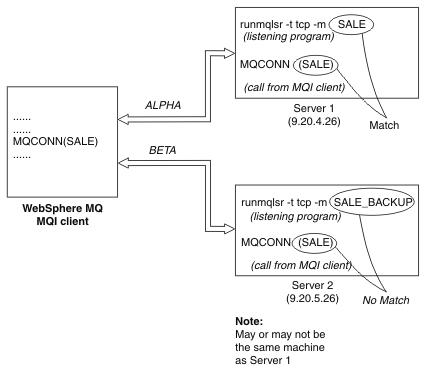Examples of MQCONN calls
Examples of using MQCONN to connect to a specific queue manager, or to one of a group of queue managers.
In each of the following examples, the network is the same; there is a connection defined to two servers from the same IBM MQ MQI client. (In these examples, the MQCONNX call could be used instead of the MQCONN call.)
There are two queue managers running on the server machines, one named SALE and the other named SALE_BACKUP.
The definitions for the channels in these examples are:
SALE definitions:
DEFINE CHANNEL(ALPHA) CHLTYPE(SVRCONN) TRPTYPE(TCP) +
DESCR('Server connection to IBM MQ MQI client')
DEFINE CHANNEL(ALPHA) CHLTYPE(CLNTCONN) TRPTYPE(TCP) +
CONNAME(9.20.4.26) DESCR('IBM MQ MQI client connection to server 1') +
QMNAME(SALE)
DEFINE CHANNEL(BETA) CHLTYPE(CLNTCONN) TRPTYPE(TCP) +
CONNAME(9.20.5.26) DESCR('IBM MQ MQI client connection to server 2') +
QMNAME(SALE)
SALE_BACKUP definition:
DEFINE CHANNEL(BETA) CHLTYPE(SVRCONN) TRPTYPE(TCP) +
DESCR('Server connection to IBM MQ MQI client')
The client channel definitions can be summarized as follows:
| Name | CHLTYPE | TRPTYPE | CONNAME | QMNAME |
|---|---|---|---|---|
| ALPHA | CLNTCONN | TCP | 9.20.4.26 | SALE |
| BETA | CLNTCONN | TCP | 9.20.5.26 | SALE |